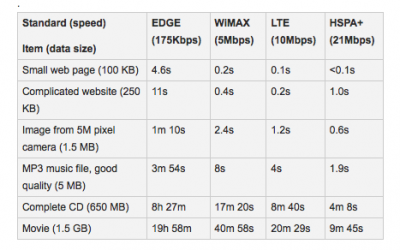
How fast can you Cellphone do this?
Recently in the Caribbean, the main mobile providers have begun to roll out “4G” services. Most mobile users are aware of “3G”, and believe their service is based on 3G technology, but is that true? Moreover, what should be their expectations regarding the much anticipated 4G roll out? This post aims to provide some insight by first highlighting the major technologies that are being used, and thereafter by comparing the data rates of popular technology standards against each other.
What is 3G? What is 4G? Where do they come from?
In order to place today’s technology in the proper context, it is useful to consider how and from where they have developed. The most significant starting point is the GSM (Global System for Mobile communications) standard. GSM is a second generation mobile technology (2G) – the most widely implemented of its time. It is also the foundation for a number of subsequent standards and technologies. A key feature of the GSM standard was that voice conversations were digitised, as opposed to earlier mobile technologies which were analogue-based. The digital format allowed transmissions to be encrypted and SMS text messaging.
Third Generation (3G) – Third generation mobile technology further developed the data carrying capacity of 2G, from SMS messaging to include mobile Internet, mobile video and TV. The caption “3G” covers broad range of standards, including EDGE, HSPA+, WiMAX, and LTE, and with each new standard, data transmission speeds increased, which in turn improved the mobile phone’s data access capability. Most 3G standards are far more efficient than 2G for voice transmissions, although operators have marketed 3G around its data capability. Nevertheless, there are limitations endemic to the 3G platform that will not satisfy the demand for broadband speeds and capabilities on mobile phones.
Fourth Generation (4G) – Fourth generation mobile technology has truly been designed to fully realise mobile broadband. Standards such as WiMAX and HSPA+, which are currently being used by Digicel and LIME, respectively, are generally considered precursors to the full 4G standard, but nevertheless could fall under the 4G umbrella. Standards that fully satisfy the 4G classification are LTE Advanced and WirelessMAN-Advanced (also called “WiMAX 2”), but they are still being finalised and will not be ready for adoption before 2012.
Is my mobile phone’s technology faster than yours?
Having outlined the evolution of mobile technologies, the key point to note is that each generation, and for the most part each standard, is an improvement on earlier generations or standards. However, with the variety of standards available and being used by mobile network operators, it can sometimes be challenging to fully appreciate their impact on the mobile phone user’s experience. Table 1 below, highlights the maximum download and upload speeds for some of the major standards that are being used, as well as those proposed for 4G.
more

 eCommerce1 year ago
eCommerce1 year ago